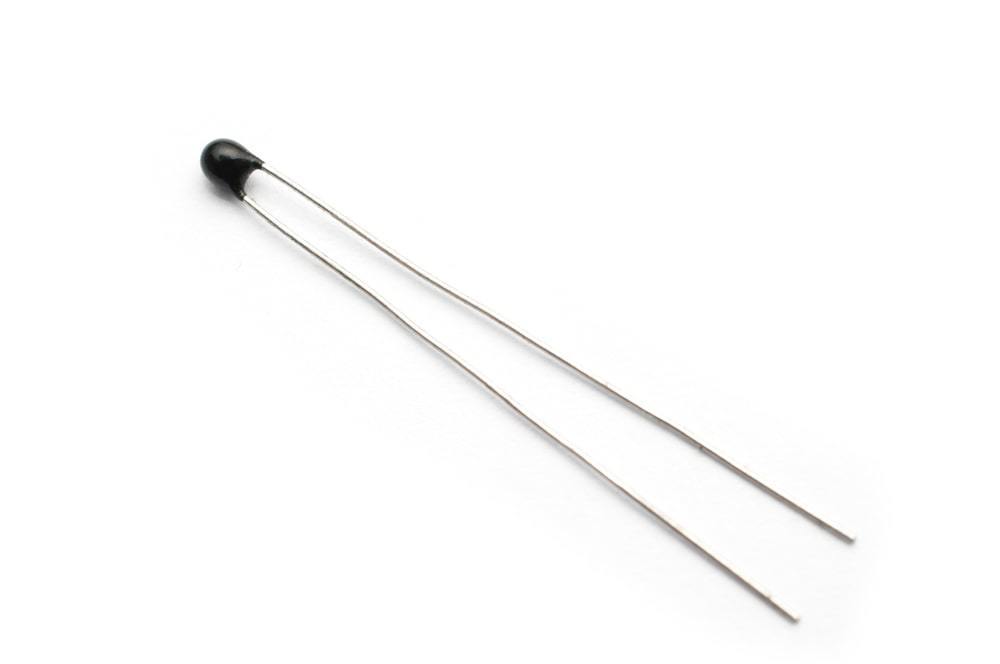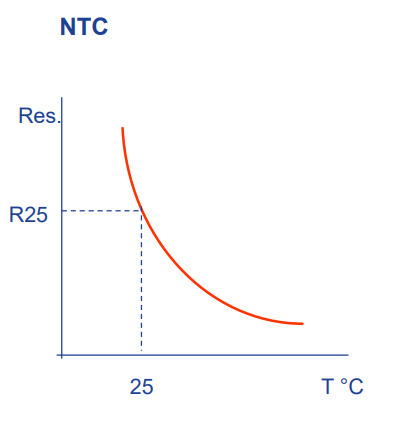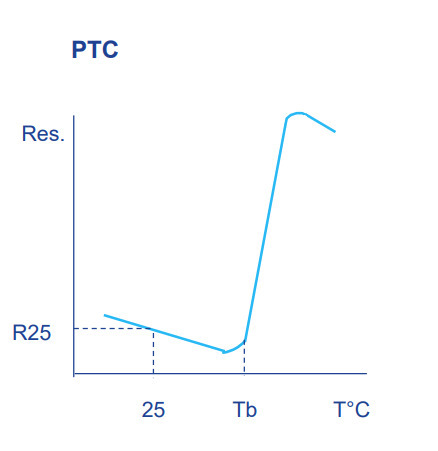
Image credit: Cristian Storto/Shutterstock.com
A thermistor is a device that can be used to establish temperature measurements by correlating the measured value of its electrical resistance to the temperature of the environment or the specific part to which the thermistor has been mounted. The term “thermistor” is derived from the concatenation and contraction of two other words – “thermal” and “resistor”. Thermistors can be thought of as thermally sensitive resistors – devices whose resistance value can be used to establish a temperature reading.
This article will examine thermistors in greater detail including what they are, how they work, the different types that are used, their applications, and the key performance parameters used when specifying these devices.
To learn more about other types of electrical and electronic devices, see our related guides, a list of which appears at the end of this article. To more about other sensor types, see our related guide – Sensors – A Complete Guide (Types, Applications, and Suppliers).
What is a Thermistor?
Thermistors are a type of temperature sensor that is used in a variety of different applications and can be viewed as a special type of resistor. All resistors generally have some temperature dependency, meaning that their resistance value will change somewhat depending on temperature. This effect is defined and measured by the temperature coefficient of resistance, or TCR. TCR can be defined as the percentage change in the value of the resistance that occurs for a given change in temperature. It is sometimes expressed in parts per million (ppm) per degree Celsius, and can be expressed as:

where R2 is the value of resistance at operating temperature T2, and R1 is the value of resistance at temperature T1, which is typically room temperature (25oC).
In typical fixed or variable resistors used in electrical circuit applications, having a small TCR is desirable as it results in stable electrical performance over a range of temperatures. For thermistors, however, a large value of TCR is preferable, as it allows for the change in resistance value with temperature to be more readily measured and used as an accurate reflection of the change in temperature.
Thermistors are often specified as an alternative to other types of thermal measurement devices such as Resistance Temperature Detectors (RTDs). (More information on other types of temperature sensors, including RTDs, may be found in our related guides All About Temperature Sensors and Types of Contact Sensors.)
Types of Thermistors and How They Work
Generally, thermistors are divided into two main types:
- Negative Temperature Coefficient, or NTC thermistors
- Positive Temperature Coefficient, or PTC thermistors
A negative temperature coefficient thermistor has the property that as temperature increases, the resistance of the device decreases. Hence the TCR value for these devices is negative and would be shown graphically as a curve with a negative slope when resistance is plotted on the y-axis and temperature is plotted on the x-axis. Figure 1 below shows an example of an NTC thermistor characteristic curve. Besides the reduction in resistance associated with increasing temperature, note that the slope of the curve is not constant and so the relationship between resistance and temperature is non-linear. Also, the steeper the curve, the greater the temperature sensitivity of the device, as a relatively small change in temperature can produce a large change in the value of the resistance of the thermistor.

Image credit: https://www.amphenol-sensors.com/
Figure 1 – Example of a Characteristic Resistance-Temperature Curve for an NTC Thermistor
Positive temperature coefficient thermistors, by contrast, have a direct relationship between the device resistance and temperature. As temperature increases (above a certain point), the resistance of the thermistor also increases. Figure 2 below shows an example of the characteristic graph of a PTC thermistor.

Image credit: https://www.amphenol-sensors.com/
Figure 2 – Example of a Characteristic Resistance-Temperature Curve for a PTC Thermistor
As can be seen from this curve, the behavior of a PTC thermistor’s resistance to temperature change is very non-linear. Initially, the device exhibits a reduction in resistance with increasing temperature, hitting a minimum value of Rmin before beginning to increase again with further increases in temperature. Once the temperature hits a critical point, (called the Curie temperature, switch temperature, transition temperature, or breakpoint temperature – Tb as shown in Figure 2), the device shows a sharp increase in resistance with each degree change in temperature. At temperatures below Tb, the device is said to be operating in a low resistance state; above Tb the device transitions to a high resistance state.
There are two primary types of PTC thermistors – thermally sensitive silicon resistors (also called silistors) and switching PTC thermistors. Figure 2 represents the characteristic curve more typical of a switching PTC thermistor. A silistor tends to exhibit a more linear increase in resistance with temperature change over its rated operating range and is used most often to provide temperature compensation for silicon semiconductor devices.
Thermistor Applications
NTN thermistors are used most frequently in temperature measurement and control applications, owing to their large resistance change with temperature. They are also used in electrical circuits where temperature compensation is needed such as with oscillators or LCD displays. Because they experience a time delay before reaching a lower resistance, another use for these devices is to function as a current limiter for inrush current. Additionally, these thermistors can find application as sensors for the presence of a liquid. When a liquid comes into contact with the device, the dissipation constant will change allowing the thermistor to detect such contact.
Switching PTC thermistors have characteristics that enable them to be used either as a heater or as a self-resettable fuse. PTC thermistors can function effectively to heat an object to a specific temperature and maintain that temperature value. The characteristic curve shown in Figure 2 illustrates that in the high resistance state, the device will tend to self-regulate at a constant (set) temperature. If the temperature decreases, the resistance decreases which will allow more current to flow through the device, dissipating more power and increasing temperature again. Similarly, should the temperature increase from the set value, the device resistance will increase, limiting current flow and causing the temperature to drop. Manufacturers can change the composition of the ceramic materials used in the construction of the PTC thermistor which can then alter to some degree the transition temperature and the regulated temperature. Applications in which PTC thermistors are used as a heater include diesel fuel heaters to heat the fuel to make cold engine starts easier, as part of wax motors for dishwasher soap dispenser door operation, in bimetallic switches, and in angle-of-attack indicators in aircraft. Numerous other applications employ PTC thermistors for heating including:
- Engine block heaters in cold climates
- Mirror deicing
- Coffee pot heaters
- Ceramic heaters
- Thermoelectric actuator valves
The sudden and dramatic high resistance change above the Curie temperature is the property that enables PTC thermistors to also be used for applications as a resettable fuse, such as to address in-rush current and provide overcurrent protection. For example, in the case of an electric motor with a set of startup windings, a PTC thermistor can be wired electrically in series with the startup coil. When the motor is initially activated, the PTC thermistor is operating in a low resistance state and allows current to pass into the startup windings. As the current flows through the device, it dissipates heat and increases in temperature. Once the device transitions to the high resistance state, the current flow to the startup windings is effectively cut off and the startup coil is disengaged from the circuit.
Similarly, PTC thermistors can function to limit current in an overcurrent situation. Should a short circuit condition develop, the sudden current flow through the thermistor will cause it to heat up quickly past the transition temperature. Once in the high resistance state, the device can limit the current flow through the circuit to prevent the short or overcurrent from continuing unabated. Once the overcurrent condition has been corrected, the current flow through the PTC thermistor drops, the device cools, and its resistance decreases as it transitions out of the high resistance state. PTC thermistors, therefore, behave as self-resettable fuses.
Performance Specifications and Key Terminology
Thermistors are defined by a number of key performance specifications and terms; some of the most significant of these are summarized below.
- Zero-load resistance – represents the resistance of the thermistor under no-load conditions, i.e. measured using a power level such that there is little to no heat generation from the operating current in the device. The measurement is typically performed at room temperature (25oC).
- Beta constant (β) – also sometimes called the B value, represents the slope of the resistance-temperature curve across a specified range of temperature. For temperatures T1 and T2, this value can be computed as:

- Alpha (α) – represents the zero-power temperature coefficient of resistance, defined as the relative change in resistance referred to the change in the temperature. It is related to the first derivative of the R-T curve and is defined as:

where R is resistance and T is temperature.
- The thermal time constant (τ) – is defined as the time that is required for the thermistor to transition to 63.2%, or ( 1 – 1/e) of the difference between the initial and final temperatures. This value is based on an exponential model for the change in temperature of the thermistor with time that can be approximated as:

- Dissipation constant (δ) – measures the amount of power needed to change the temperature of the thermistor by 1oC through self-heating from the applied bias current. The value is measured at a specific ambient temperature and has units of mW/oC.
Summary
This article reviewed the basics of thermistors, including what they are, how they work, the types, and their applications. For information on other topics, consult our additional guides or visit the Thomas Supplier Discovery Platform where you can locate potential sources of supply for over 70,000 different product and service categories, including suppliers of NTC and PTC thermistors.
Sources:
- https://www.variohm.com
- https://www.sensorsci.com/thermistors
- https://www.electronics-notes.com/
- https://www.teamwavelength.com/thermistor-basics/
- https://www.littelfuse.com/
- https://eepower.com/
- https://www.amphenol-sensors.com/en/thermometrics
- https://www.electronics-notes.com/
Related Sensor Articles:
- Top Motion Sensor Suppliers and Manufacturers in the USA and Internationally
- Capacitive Proximity Sensors
- Types of Temperature Transmitters
- Top Biosensor Companies in the USA and Internationally
- Shaft-Angle Encoders
- Top Proximity Sensors Suppliers and Manufacturers in the USA and Worldwide
- Exhaust Gas Analyzers
- Top Temperature Sensors Manufacturers and Suppliers
- Top Sensors Manufacturers and Suppliers in the USA
- Motion Light Sensors
- Top Pressure Sensor Suppliers and Manufacturers in the US
- Types of Pressure Sensor – A Guide
- Different Types of Sensors and their Uses (i.e. Electrical Sensors)
- All About Position Sensors – Types, Uses and Specs)
- All About Radiation Detectors
- All About Motion Sensors
- All About Particle Sensors
- All About Photoelectric Sensors
- Top Internet-of-Things (IOT) Companies in the USA
- All About Leak Sensors – How They Work and Their Applications

